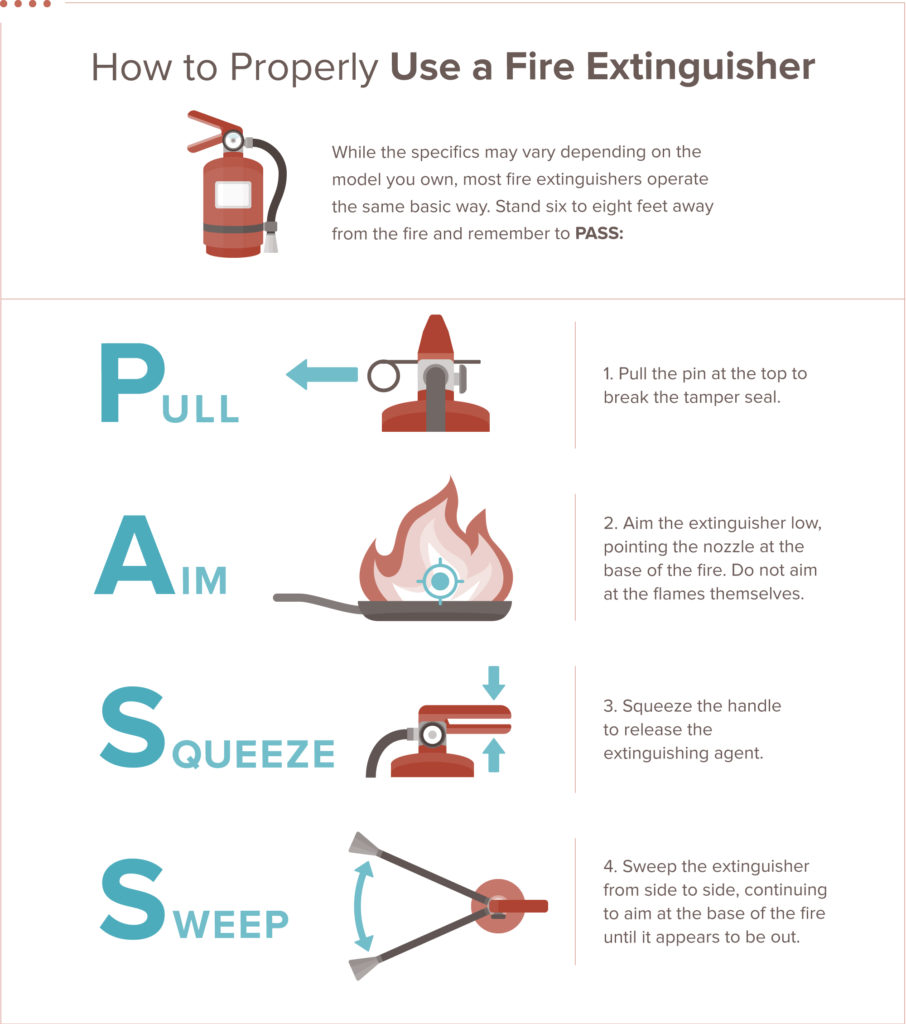Which Of The Following Is A Good Technique When Using A Fire Extinguisher?
Be Prepared: How to Properly Utilise a Burn down Extinguisher
We should all have at least one burn down extinguisher somewhere in our home, but information technology'south not enough to just keep ane under the kitchen sink. If at that place is a fire, your safety—and the safety of your dwelling house—depends on knowing how to utilize that fire extinguisher correctly.
In instance your fire extinguisher has been sitting around collecting dust, here'southward everything you demand to know before brushing it off and fighting a fire in your home the right way.
Choose the right fire extinguisher
The first thing you need to know is the different classifications of fires, and the 2d that not all burn, y'all need to understand what types of fires you may take to deal with and brand sure your extinguisher can go the job done.
Most household fires fall into one of the following categories:
Class A: These fires are fueled by solid combustibles like wood, newspaper, and cloth.
Class B: These fires are fueled by flammable liquids such as oil, petroleum, and gasoline.
Course C: These fires are started or fueled by faulty wiring, fuse boxes, and appliances.
Class Yard: These fires are started or fueled by cooking oils and greases, animal fats, and vegetable fats.
All fire extinguishers are labeled to betoken which classes of burn they are designed to gainsay. Most household fire extinguishers are considered multipurpose and labeled for employ in A, B, and C classes. Class G extinguishers are heavier duty and will need to be bought separately. We suggest this 6-liter extinguisher, every bit it best fits the Burn down Department Connexion'south recommendation.
Fire extinguisher labels also include symbols to indicate which types of fires the extinguisher is designed to fight. If there is a circle and a carmine slash through whatsoever of the symbols, that indicates that the extinguisher cannot be used to fight that type of burn.
Household fire extinguishers are also rated for the size of fire that they tin safely handle. The higher the rating (equivalent to the number of gallons of water it would accept), the larger the fire the extinguisher can put out.
- Grade A fires are rated 1 to 40.
- Grade B fires are rated from one to 640.
- There is no size rating for Class C fires.
Note that higher-rated extinguishers are oft heavier, so be certain that you lot can comfortably handle the size of the fire extinguisher yous keep at home.
How to use a burn down extinguisher
In one case yous sympathize the different types of fire extinguishers and their uses, y'all need to exist able to properly operate 1.
The best fashion to exist ready for a fire emergency in your home is to study the steps beneath and review them regularly so you tin protect your domicile and family.
1. Place a clear exit/escape route
Before operating the fire extinguisher, make sure yous have a clear evacuation path. If you cannot put out the burn down, you lot'll need to make a condom exit. Consider this when determining where to store your fire extinguisher, and make certain you'll have multiple go out options nearby after you call back it.
ii. Stand back
Face the burn down and keep your dorsum to the articulate leave you before identified. You should stay betwixt six and 8 feet away from the flames as you prepare to operate the fire extinguisher.
3. Discharge extinguisher
It tin can be hard to remember conspicuously during an emergency, so fire condom has a long-continuing acronym to help yous recollect the steps involved in operating your fire extinguisher. When extinguishing a fire, you should PASS:
P: Pull the pivot on the fire extinguisher.
A: Aim the extinguisher nozzle on the hose low, toward the base of operations of the burn down.
Southward: Clasp the handle or lever to belch the extinguisher.
Due south: Sweep the nozzle back and forth. Go along the fire extinguisher aimed at the base of the fire and move it from side to side until the flames are extinguished.

iv. Keep an centre on things
After the flames appear to be out, continue to watch the burn area to brand sure information technology doesn't reignite. If the fire does start up again, echo the PASS procedure.
5. Phone call the burn down department
If you didn't accept the hazard to call the local fire section before discharging the fire extinguisher, do so now. They will be able to inspect the site of the fire and brand sure that information technology is completely extinguished.
half-dozen. Get to a safe identify
Once the fire is out, or if yous are unable to extinguish the fire, leave the scene and find a identify out of reach of the fire.
Common burn down extinguisher mistakes
Considering we don't have regular opportunities to practice fighting fires, it's easy to make unproblematic mistakes when the fourth dimension comes. Know where most people become wrong then you tin can avert making a mistake while under pressure.
- Don't ignore the instructions: Thoroughly read the operating instructions that came with your burn down extinguisher. Make sure all able members of your domicile read and sympathize the instructions. Review them regularly when you lot acquit burn down drills and go over your evacuation plan.
- Don't use the wrong type of fire extinguisher: Never use a fire extinguisher for a class of burn that is non indicated on the label. Most chiefly, extinguishers that are labeled for Class A fires but cannot be used on electric or grease fires. However, it is safe to use an extinguisher labeled for Course B and C fires on a Grade A fire. While Class K fires are technically a subset of Course B fires, other contents in Class B extinguishers can make Class K fires worse, so information technology's all-time to get a dissever extinguisher for cooking fires.
- Don't permit your extinguisher go bad: Burn down extinguishers come with an expiration appointment, later on which the extinguishing agent is no longer effective. Know the dates on your burn extinguishers and supercede them as needed.
- Don't neglect burn extinguisher maintenance: The extinguisher's pressure needle should always point to the greenish zone. When it drops to the cherry zone, it doesn't have enough pressure to release the extinguishing agent. This can happen even if the extinguisher is never used. Adding pressure (also called "recharging") makes the extinguisher fully functional once more, but this isn't a DIY chore. A certified fire services visitor should recharge the fire extinguisher for you. OSHA requires portable fire extinguishers in the workplace to be recharged or tested every half dozen years.1 Homeowners can follow the same timeline.
- Don't forget nigh exits: When y'all decide where to keep your fire extinguisher, make sure it is in an hands attainable location near exterior doors. Also, consider the about mutual places where fires occur in a home and place your extinguishers accordingly.
- Don't keep it a secret: Brand certain that everyone in your home knows where the fire extinguishers are kept. Share the location, forth with your entire fire escape program, with babysitters, business firm sitters, and whatsoever long-term visitors.
Next steps
The best way to go on your home and family safety in the event of a fire is to be prepared. Regularly review how to utilize a fire extinguisher and bespeak out the location of each one in your home. A little avant-garde practice tin make all the difference when you're faced with the stress of an actual burn in your home.
Need a fire extinguisher? Check out our buyer'southward guide:Best Fire Extinguishers
Compare the meridian home rubber products
Data as of postal service date. Offers and availability may vary by location and are subject area to alter. SafeWise uses paid Amazon links.
†Google and Google Nest Secure are trademarks of Google LLC.
Recent Manufactures
Back To Top
Which Of The Following Is A Good Technique When Using A Fire Extinguisher?,
Source: https://www.safewise.com/blog/prepared-properly-use-fire-extinguisher/#:~:text=P%3A%20Pull%20the%20pin%20on,the%20nozzle%20back%20and%20forth.
Posted by: coffeysamot1998.blogspot.com



0 Response to "Which Of The Following Is A Good Technique When Using A Fire Extinguisher?"
Post a Comment